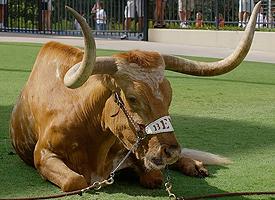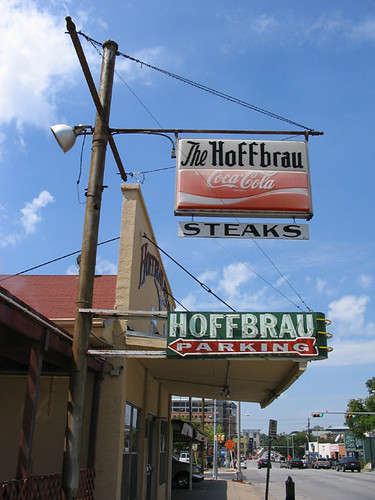(Mexico, D.F.) For reasons I cannot explain, most of my trips to Mexico seem to run into highly politicized situations that are making national headlines, like hearing PRD presidential candidate Lopez Obrador's speech in Mexico City's zocalo our first day back this week. (See
John Ross' account of the speech and a good analysis of what's going on with the elections.)
It hasn't always been that way. My first trip to Mexico on my own was at age 17 - some friends and I told our parents we were going hunting on a friend's deer lease around Llano and instead headed to the red light district in Nuevo Laredo for what used to be, for Texas men my age and older, a traditional, debaucherous rite of passage.
For the next few years
norteño border towns were my main experience with Mexico until 1994, when Kathy and I took our first extended trip into the Mexican interior. Traveling on our way to the Yucatán, we found ourself in Chiapas on Columbus day (or
Dia de la Raza, to most Mexicans) when 40,000 Indians, most of them speakers of native tongues like Tzeltal and Tzotzil with no more Spanish than I had, descended on the city of San Cristobal de las Casas to protest in support of the Zapatista armed resistance movement in that state. At the time I did a fair bit of freelance journalism, so I hired a translator to speak to folks and wrote a story on a rented manual typewriter that was faxed back to the Austin Chronicle and ran as a cover story.
A couple of years ago when Kathy and I were again traveling in southern Mexico, this time in Oaxaca, more or less the consummate tourist town outside of beach citadels like Cancún or Acapulco, we witnessed the beginning of a bitter teachers' strike that's still going on today. Hundreds of tents filled the downtown streets with teachers and their families demanding cost of living increases to match the damage done by the then-declining peso, a scene much like we're seeing in the streets of Mexico City today as part of protests staged by Lopez Obrador's supporters. The strike in Oaxaca is one of the most intense labor disputes this country has seen in many years. Since we've been in Mexico this time, the husband of one of the main teacher organizers was gunned down by thugs allegedly associated with the PRI, the political party that ruled Mexico for 70 years after the Mexican Revolution and still controls state government in Oaxaca.
On this visit, all of Mexico seems to be blowing up. As the
LA Weekly described it,
Mexico is now in a state of all-out political instability, and not just in the capital, where López Obrador supporters have taken over the Zócalo as well as Paseo de la Reforma, a major avenue. The dispute had been notably peaceful until Monday, when federal police battered activists and legislators who attempted to set up an encampment near the Congress’ lower House of Deputies.
To the south, in Oaxaca, a protracted and bloody labor dispute between the teachers union and the state government is worsening. To the north, there’s been little progress made in the spate of kidnappings and murders of women in Ciudad Juárez. And in cities across the country, harrowing drug trade–related executions remain gory staples of the daily news digest.
Rough stuff, and a sharp contrast to my soft, cushy tourist experiences described in the last few HR posts. So I thought I'd offer a few
extranjero observations on what little politics I've seen and understood (given my limited
español turistico) since we've been here.
When we got back to Mexico City from Veracruz for the final week of our trip, the first evening we went down to the zocalo at the town center to find a sizable crowd amidst the tent-city of protesters listening to an array of speakers culminating with Lopez Obrador himself, known to his supporters by his initials AMLO and portrayed in countless political posters and cartoons as a cheerful buck-toothed presidential hope for the future. Obrador was mayor of Mexico City before running for president, and by all accounts and my own observations the city improved mightily for his efforts. Thus a lot of his base is right here in the world's largest city, and it shows from the array of protesters in the tent cities, bumper stickers on cars, taxis and street vendor stands and even signs in home windows declaring
Voto por Voto - e.g., demanding a vote by vote nationwide recount. The national election commission is only doing a partial recount, and I've not spoken to anybody who believes the current ruling party, PAN, won't be declared the ultimate winner by that body.
The whole national election mess will remind every American of Florida in 2000, with a key difference: the three main national parties - the leftist PRD, the right wing PAN, and the former ruling PRI - split the vote with the top two voter-getters earning a little more than one third apiece and the PRI lagging at third. All three parties earned a respectable minority in Congress with no clear majority. Mexico is a three-party state.
PAN's presidential candidate supposedly received .58 percentage points more than the PRD on election day, said the initial results. The PRD, though, immediately began complaining of widespread election fraude, and it seems highly likely that occurred in some cases. To
quote John Ross, who is one of the best English-speaking reporters on Mexican politics:
Inside the counting rooms, Mexico's 2006 presidential election, exalted by the U.S. State Department as a paragon of democracy, was not a pretty sight. Hundreds of ballot boxes warehoused under military guard had been broken into, their seals ripped open, and the contents contaminated. Sometimes the ballots were scattered on the floor of the warehouse, sometimes there were no ballots inside the boxes to verify what the tally sheets ("actas") affirmed. When AMLO's representatives grew apoplectic at the wholesale fraud, the judges ordered the military to expel them from the recount.
Jalisco, a PAN citadel, was the first state to report results on election night--there was a governor's race on the ballot as well as the presidential vote and the PAN seemed to have kicked ass, building up a 70 percent landslide. But the results seemed so out of whack with national numbers (Calderon was awarded a highly dubious .58 per cent victory by the IFE) that the judges ordered more than 1700 casillas in the state reopened.
The new count did not sustain Calderon's Election Day claims. In 15 ballot boxes in District 3 (Tepatitlan), the PANista had been awarded 2700 votes according to the tally sheets that could not be found in the ballot boxes. Lopez Obrador, meanwhile, picked up 250 votes in the district, about 12 per casilla--Calderon's disputed 243,000 "victory" breaks down to about 1.8 per casilla.
If Ross' estimates are close to accurate, Obrador probably did win the election. In response, AMLO has urged his followers to continue their protest encampments potentially for "years" if his PAN opponent is declared president, as nearly everyone believes he will be. At the speech we heard (about which I learned more from translating the newspaper with a dictionary the next morning than I understood at the time), Obrador told his followers to continue peaceful civil resistance, which so far has included shutting down the stock exchange and taking over highway toll booths to allow travelers to pass through without paying. On Monday police tear gassed protesters who tried to set up another encampment outside of the Mexican Congress.
At one point during Obrador's speech, somebody set of a skyrocket that burst with a loud pop, and for a moment I thought for sure we were witnessing an assassination attempt. An elderly lady next to me looked up with a nervous grin, crossing herself, and said "Por Dios," before wiping her forehead with relief- I suspect she thought the same thing. It seemed an ill-timed moment for such a display.
Obviously, I have no way to know whether vote fraud took place or how much, but you don't need to be an expert in Mexican politics to see that this is a very divided country. PAN is strong in the northern states, representing elements that in the US would be considered the religious right as well as the interests of American capital. PRD's base is the poorest of the poor, especially in southern Mexico and Mexico City. Meanwhile the PRI represent many old-guard unions and other middle class interests, in addition to remnants of the ruling coalition that dominated the country for most of the last century. Bottom line, there's little that unites them. While the PRI would love to oust the PAN candidate, their interests hardly coincide with Lopez Obrador, whose populist agenda would overturn many of the PRI's most prized neoliberal reforms, most prominently participation in NAFTA.
Still, I'm not sure long-term civil disobedience will position the PRD well, especially if it continues, as per Obrador's urging, for years to come as it has now with teachers in Oaxaca. However you look at it, even if the PRD actually won a plurality, 2/3 of the country didn't want whichever candidate ultimately assumes the presidency. Civil disobedience might be a better option if the majority supported their candidate, but the longer it goes on, especially after a president has been formally declared, I would fear (if I were a PRD strategist) that recalcitrance would damage the party irrevocably in the long term. (UPDATE:
John Ross says some of AMLO's middle class supporters are already criticizing him for worsening Mexico City's traffic.)
That said, claims that protests are harming the economy are laughable. Mexico City's center is as vibrant as ever. Our hotel was full when we arrived and we had to take a more expensive room. The streets covered with tents and tarps are filled with shoppers all day and evening, and the air smells cleaner for the lessened traffic. (From what I've seen, traffic in the center has been hindered more by significant roadwork being done near the center than by the two roads blocked off by demonstrations.) But shops and restaurants are bustling, the street stalls are doing land-office business, and nothing I've witnessed indicates commerce has been harmed in the least. Indeed, it's probably been helped by the influx of protesters camping in center of town.
High drama, from any perspective. God knows how it will turn out. But in any event, it's odd how, whenever Kathy and I come to Mexico we seem to walk into the middle of a political clusterfuck. Or, to look at it another way, history in the making.























